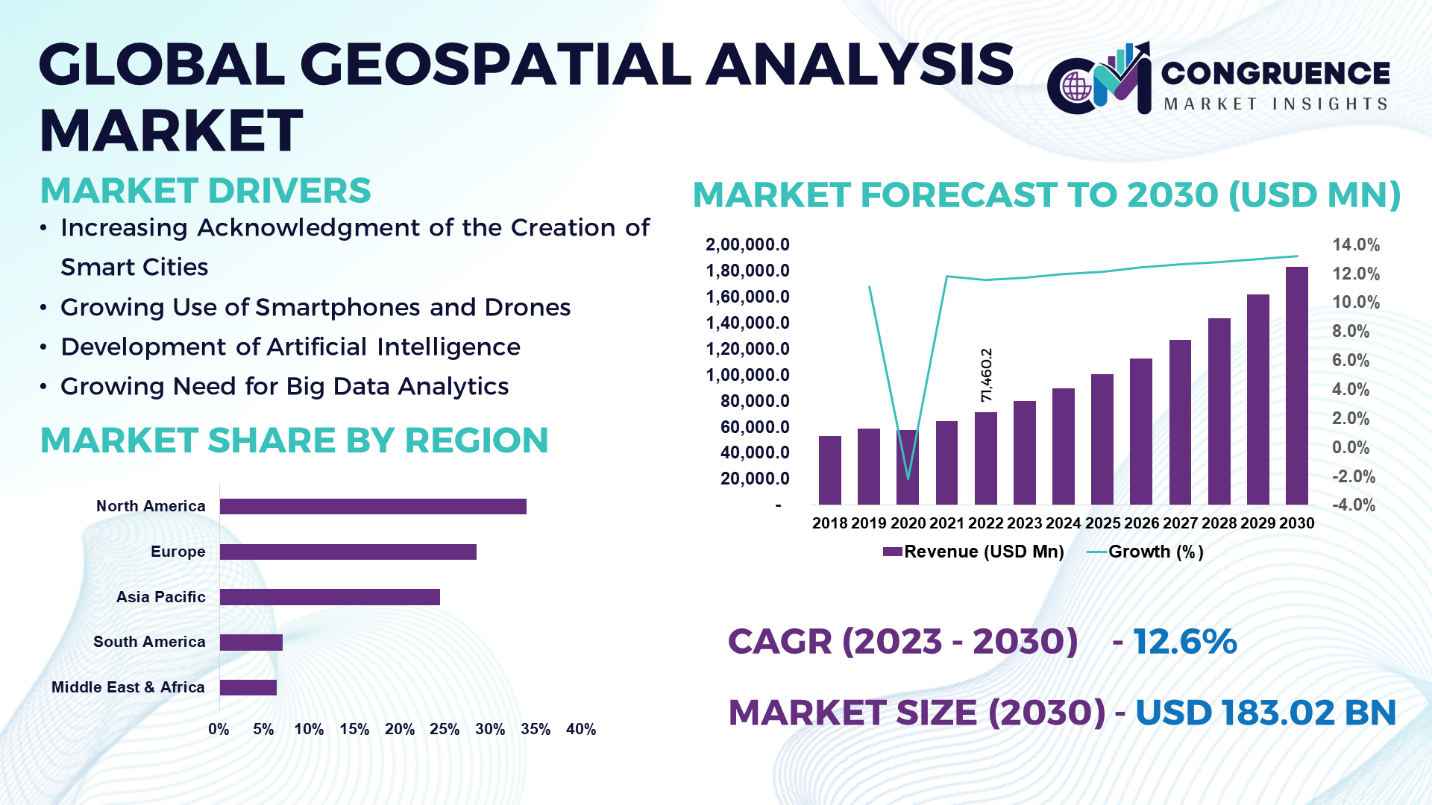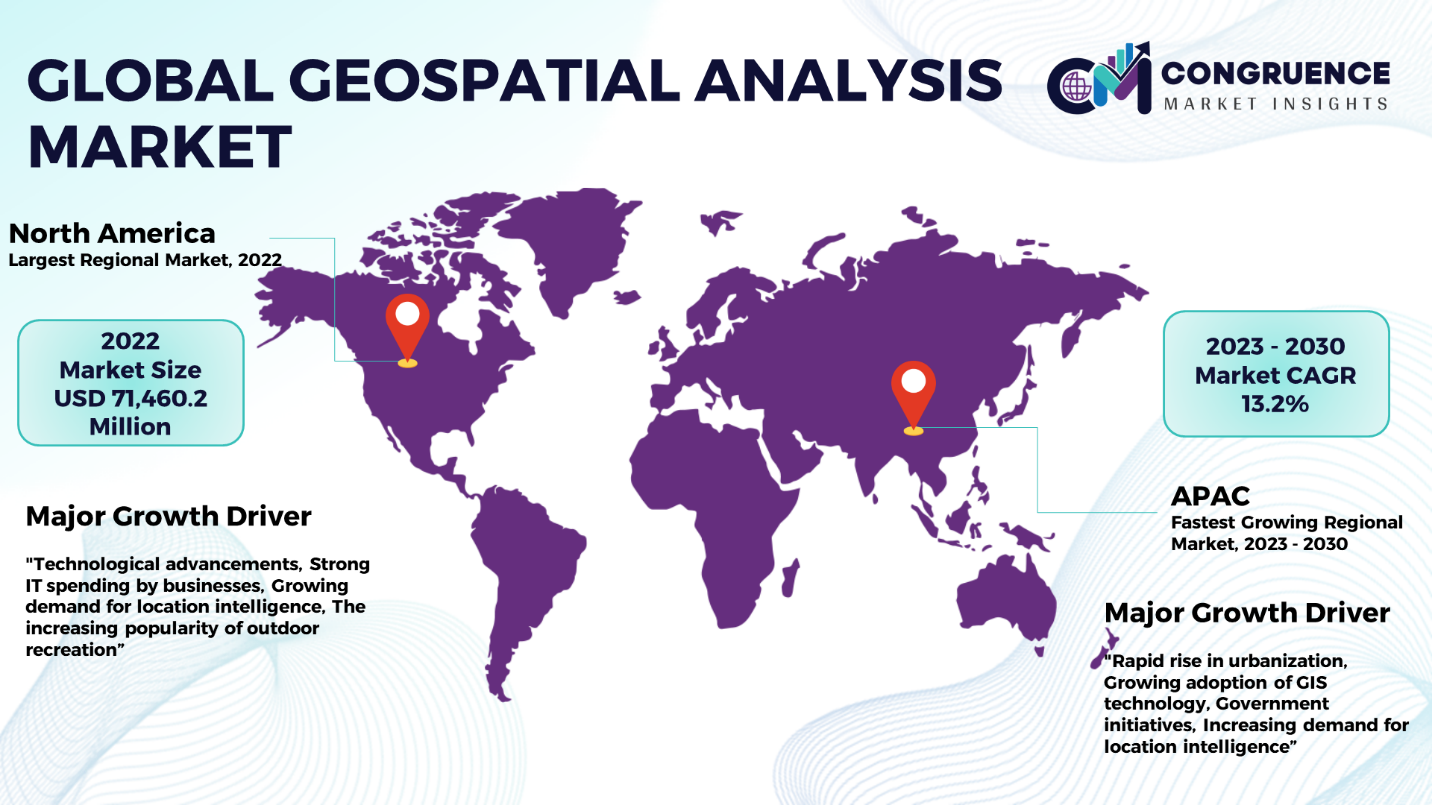Reports
The Global Geospatial Analysis Market was valued at USD 71,460.2 Million in 2022 and is anticipated to reach a value of USD 183,023.8 Million by 2030 expanding at a CAGR of 12.6% between 2023 and 2030.
The gathering and processing of information on the basis of geography is known as geospatial analytics. To offer precise simulation, trend analysis, and forecasts, it employs the use of a variety of technology techniques, such as remote sensing, georeferencing, Geographic Information Systems (GIS), GPS, and metadata. Additionally, such statistics separate usable and pertinent information from unrelated data sets. Geographical and spatial data are analyzed using a variety of analytical methods, including statistical analysis, in geographic analysis. Through the aid of GIS and geomatics, it additionally facilitates the utilization of computer applications that may analyze spatial data, create maps, and implement analytical techniques for geographic or terrestrial information. Furthermore, business information systems inside a company may readily include geographic information systems. These benefits are the main forces behind the geospatial analytics market's expansion. In the beginning, geospatial analytics was created with an emphasis on ecology, epidemiology, and geology to address issues facing the biological and life sciences sectors. The technology is being extensively utilized over time to serve a broad spectrum of businesses, such as public safety, utilities, government and defense, healthcare, and natural resources. It is also widely used in disaster risk reduction and management (DRRM) and climate change adaptation (CCA).

Geospatial Analysis Market Major Driving Forces
Increasing Acknowledgment of the Creation of Smart Cities: Geospatial analytics solutions are now the foundation for these developments. In smart cities, geographic information systems (GIS) are becoming a necessary component of daily living. From conceptualization and creation to implementation and maintenance, GIS offers an IT infrastructure that unifies all parties and all smart city operations.
Growing Use of Smartphones and Drones: The growing use of smartphones with GPS capabilities and the development of drone technology are two other important drivers driving the geospatial analytics market. These developments in technology allow for the real-time collection and analysis of geospatial data, enabling companies to make decisions that are well-informed and grounded on current, accurate information.
Development of Artificial Intelligence and Other Technologies: The rise of geospatial analytics is being driven by the growing use of big data analytics, cloud computing, IoT, AI, and other business intelligence technologies. Furthermore, a large number of remote sensing satellites, fast internet, communication network infrastructure, and the growing use of unmanned aerial vehicles (UAVs) to collect geospatial data are anticipated to fuel market expansion.
Growing Need for Big Data Analytics: Big data analytics is improving data handling capabilities by processing large volumes of data in the shortest amount of time. This is in contrast to the increasing prominence of social media platforms and the increasing utilization of geospatial technologies, which make it more challenging to assess and map the data. Other supplementary technologies that have been introduced include cloud services and embedded sensors. Consequently, there is going to be a rise in the need for big data skills and geographic analytics solutions.
Geospatial Analysis Market Key Opportunities
Prevalence of AIGIS: Artificial intelligence technology and various GIS processes, such as geographical data analysis algorithms, are combined to create AI GIS (artificial intelligence geographic information system). In recent decades, geoscience research and applications have shifted their primary attention to AI GIS. Consequently, the market is being driven by the increasing use of machine learning and artificial intelligence in GIS systems.
Environmental Monitoring and Protection: By recording fluctuations in air quality, water quality, and land cover, geospatial analytics may be utilized to track and safeguard the ecosystem. Climate change, pollution, and deforestation are just a few of the environmental issues that may be identified and addressed using this knowledge.
Public Safety and Emergency Response: Geospatial analytics may be used to provide real-time information regarding crime patterns, traffic congestion, and natural catastrophes, which can help enhance public safety and emergency response. By using this data, resources can be allocated more wisely, crises can be handled faster, and crime may be avoided.
Geospatial Analysis Market Key Trends
· Geospatial analytics is becoming increasingly vital for managing assets, facilities, and transportation in urban areas as they become more crowded.
· The ability to gather, process, and visualize geographic data is becoming more straightforward with the introduction of new technologies such as artificial intelligence (AI) and machine learning (ML).
· Companies are spending more and more money on geospatial analytics tools to help them make better decisions.
· In the geospatial analytics space, predictive analytics is becoming more and more popular since it helps companies and organizations anticipate trends and take proactive measures to address them. Predictive analytics, for instance, may be used to forecast natural disasters, uncover prospective business possibilities, and predict customer behavior.
Region-wise Market Insights
North America accounted for the largest market share at 33.9% in 2022 whereas, Asia Pacific is expected to register the fastest growth, expanding at a CAGR of 13.2% between 2023 and 2030.

Europe is anticipated to have a larger proportion of the geospatial analytics market, making it the dominant region. Innovative artificial intelligence (AI) and expanding geographic information systems are driving growth in the advanced technology sector in the United Kingdom. The widespread application of GIS is probably going to increase the company's production in the next years. Additionally, the region's market would develop due to increased awareness of geospatial data. In order to make wise selections for the firm in the area, marketing intelligence and staff members of the organization are also keeping an eye on real-time data. In North America, by contributing to the development of the contemporary geospatial cloud, the USA is quickening the rate of expansion of the regional market. Additionally, it allows for significant sharing and additional applications for online services and data storage. Moreover, the need for contemporary geospatial clouds will increase due to the availability of current geographic information, growing economic value, and organizational acceptance. However, data scientists and software engineers in the area use it extensively. The Asia-Pacific region is driving a sizable portion of the geospatial analytics market share. Geospatial analytics are expected to be in high demand in India owing to the country's growing use of GIS technology in the agriculture industry. This technology offers information on crops at various stages and contributes to the creation of dynamic agriculture. Moreover, GIS provides efficient goods in a healthy setting by facilitating the management and control of farming in the area with this technology.
Market Competition Landscape
In the worldwide market for geospatial analytics, producers are in an intense rivalry with one another. Prominent firms in the geospatial analytics industry employ techniques to outperform their rivals. Established companies depend on their reputation for dependability and quality to hold onto market share, whereas more recent competitors emphasize disruptive technologies and unique selling propositions (USPs). Prominent firms operating in the worldwide geospatial analytics industry employ an array of inorganic and organic tactics to uphold and enhance their market standing. Well-known companies in the field include:
· ESRI (Environmental Systems Research Institute)
· Hexagon AB
· Trimble Inc.
· IBM Corporation
· Oracle Corporation
· Bentley Systems
· Pitney Bowes
· TomTom
· HERE Technologies
Owing to the Google Maps platform, Google holds a significant market share in the geospatial analytics space. Google Maps is a popular tool for business mapping, location-based services, and navigation. Additionally, the business offers developers APIs so they may include mapping features in their apps. As a component of its larger analytics and cloud offerings, IBM provides geospatial analytics solutions. The business uses geospatial technology for asset tracking, location-based analytics, and spatial data management, among other uses.
|
Report Attribute/Metric |
Details |
|
Market Revenue in 2022 |
USD 71,460.2 Million |
|
Market Revenue in 2030 |
USD 183,023.8 Million |
|
CAGR (2023 – 2030) |
12.6% |
|
Base Year |
2022 |
|
Forecast Period |
2023 – 2030 |
|
Historical Data |
2018 to 2022 |
|
Forecast Unit |
Value (US$ Mn) |
|
Key Report Deliverable |
Revenue Forecast, Growth Trends, Market Dynamics, Segmental Overview, Regional and Country-wise Analysis, Competition Landscape |
|
Segments Covered |
· By Industry Vertical (Government, Transportation, Utilities, Agriculture, Healthcare, Retail, And Others) · By Application Area (Urban Planning, Environmental Monitoring, Defense, Telecommunications, Disaster Management, And Others) · By Company Size (Large Enterprises, Small And Medium Enterprises (SMEs)) · By Technology Type (Satellite-Based, GIS Solutions, Lidar Technology, IoT Integration) |
|
Geographies Covered |
North America: U.S., Canada and Mexico Europe: Germany, France, U.K., Italy, Spain, and Rest of Europe Asia Pacific: China, India, Japan, South Korea, Southeast Asia, and Rest of Asia Pacific South America: Brazil, Argentina, and Rest of Latin America Middle East & Africa: GCC Countries, South Africa, and Rest of Middle East & Africa |
|
Key Players Analyzed |
ESRI (Environmental Systems Research Institute), Hexagon AB, Trimble Inc., IBM Corporation, Google, Oracle Corporation, Bentley Systems, Pitney Bowes, TomTom, HERE Technologies |
|
Customization & Pricing |
Available on Request (10% Customization is Free) |
